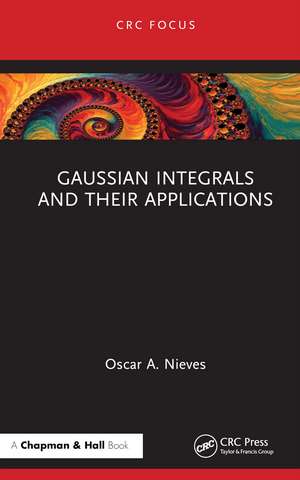Gaussian Integrals and their Applications
Autor Oscar A. Nievesen Limba Engleză Hardback – 30 iul 2024
In Gaussian Integrals and their Applications, the author has condensed the material deemed essential for undergraduate and graduate students of physics and mathematics, such that for those who are very keen would know what to look for next if their appetite for knowledge remains unsatisfied by the time they finish reading this book.
Features
- A concise and easily digestible treatment of the essentials of Gaussian Integrals
- Suitable for advanced undergraduates and graduate students in mathematics, physics, and statistics
- The only prerequisites are a strong understanding of multivariable calculus and linear algebra.
- Supplemented by numerous exercises (with fully worked solutions) at the end, which pertain to various levels of difficulty and are inspired by different fields in which Gaussian integrals are used.
Preț: 376.64 lei
Preț vechi: 409.38 lei
-8% Nou
Puncte Express: 565
Preț estimativ în valută:
72.08€ • 74.82$ • 60.10£
72.08€ • 74.82$ • 60.10£
Carte disponibilă
Livrare economică 04-18 martie
Livrare express 15-21 februarie pentru 30.84 lei
Preluare comenzi: 021 569.72.76
Specificații
ISBN-13: 9781032816173
ISBN-10: 1032816171
Pagini: 82
Ilustrații: 20
Dimensiuni: 138 x 216 x 14 mm
Greutate: 0.45 kg
Ediția:1
Editura: CRC Press
Colecția Chapman and Hall/CRC
Locul publicării:Boca Raton, United States
ISBN-10: 1032816171
Pagini: 82
Ilustrații: 20
Dimensiuni: 138 x 216 x 14 mm
Greutate: 0.45 kg
Ediția:1
Editura: CRC Press
Colecția Chapman and Hall/CRC
Locul publicării:Boca Raton, United States
Public țintă
Postgraduate and Undergraduate AdvancedCuprins
1. Elementary Results. 1.1. The Gaussian Function. 1.2 The Gaussian Function in Multiple Dimensions. 1.3. An Unexpected Derivation. 1.4. Powers of Incomplete Squares. 1.5. The Fourier Transform of a Gaussian. 1.6. The Error Function. 2. Compound Gaussian Integrals. 2.1. Polynomials of Even Order. 2.2. Polynomials of Odd Order. 2.3. Polynomials of Non-Integer Order and the Gamma Function. 2.4. Higher Order Gaussian Integrals. 3. Multivariate Gaussian Integrals. 3.1. Exponents of Scalar Terms. 3.2. Exponents of Quadratic Forms. 4. Applications. 4.1. Fresnel Integrals. 4.2. The Normal Distribution. 4.3. The Log-Normal Distribution. 4.4. Brownian Motion and Diffusion. 4.5. Path Integrals in Quantum Theory.
Notă biografică
Oscar A. Nieves is a theoretical physicist working in applied superconductivity research. His research focuses on the modelling of
superconducting electronics, quantum sensors and photonic devices using semi-classical methods.
Oscar completed his PhD in Theoretical Physics from the University of Technology Sydney (UTS) in Australia, with the thesis entitled “Noise Dynamics in Stimulated Brillouin Scattering”. Here, he investigated the role of thermal noise and laser noise in the interaction between light pulses and acoustic waves in dielectric waveguides, otherwise known as the stimulated Brillouin scattering interaction (SBS); and the possible limitations this has for the realization of photonic devices that exploit this interaction, including: amplifiers, filters and short-term memory storage devices. During this degree, Oscar studied stochastic processes very closely, and frequently came across things like the normal and log-normal probability distributions, from which his interest in Gaussian integrals emerged.
Prior to his PhD, he conducted research in simulating the optical response of one-dimensional periodic metasurfaces, investigating the relation between surface curvature and reflectance properties using the Finite-Difference Frequency-Domain (FDFD) method, which he programmed in MATLAB.
His main areas of interest include: numerical methods for physics applications, numerical solution of partial differential equations,
stochastic modelling, quantum devices, electromagnetic theory and machine learning. He also enjoys writing Python codes for solving different types of problems, especially in relation to stochastic dynamics.
Aside from his day-to-day research activities, Oscar also finds happiness in teaching applied mathematics and physics. He has taught a variety of university courses ranging from introductory Calculus and statistics to partial differential equations and complex analysis.
superconducting electronics, quantum sensors and photonic devices using semi-classical methods.
Oscar completed his PhD in Theoretical Physics from the University of Technology Sydney (UTS) in Australia, with the thesis entitled “Noise Dynamics in Stimulated Brillouin Scattering”. Here, he investigated the role of thermal noise and laser noise in the interaction between light pulses and acoustic waves in dielectric waveguides, otherwise known as the stimulated Brillouin scattering interaction (SBS); and the possible limitations this has for the realization of photonic devices that exploit this interaction, including: amplifiers, filters and short-term memory storage devices. During this degree, Oscar studied stochastic processes very closely, and frequently came across things like the normal and log-normal probability distributions, from which his interest in Gaussian integrals emerged.
Prior to his PhD, he conducted research in simulating the optical response of one-dimensional periodic metasurfaces, investigating the relation between surface curvature and reflectance properties using the Finite-Difference Frequency-Domain (FDFD) method, which he programmed in MATLAB.
His main areas of interest include: numerical methods for physics applications, numerical solution of partial differential equations,
stochastic modelling, quantum devices, electromagnetic theory and machine learning. He also enjoys writing Python codes for solving different types of problems, especially in relation to stochastic dynamics.
Aside from his day-to-day research activities, Oscar also finds happiness in teaching applied mathematics and physics. He has taught a variety of university courses ranging from introductory Calculus and statistics to partial differential equations and complex analysis.
Descriere
In this book, the author has condensed the material deemed essential for undergraduate and graduate students of physics and mathematics, such that for those who are very keen would know what to look for next if their appetite for knowledge remains unsatisfied by the time they finish reading this book.
